Αὐσοβα Ποταμου Εκβολαι
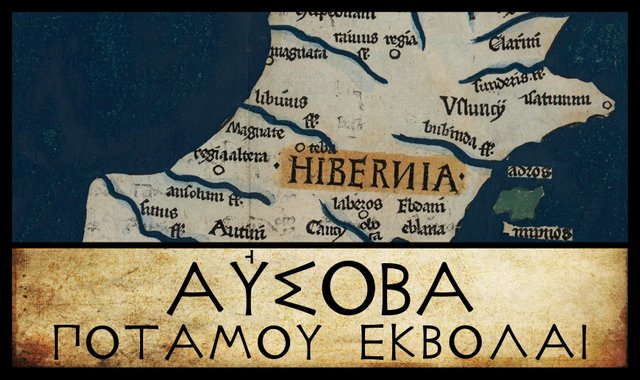
Sailing down the west coast of Claudius Ptolemy’s Ireland, our next landfall is the mouth of the River Ausoba. The three modern editors I am following place this feature in the same longitude as the mouth of the River Libnios, 10° 30', but half a degree to the south. A handful of manuscripts record the longitude as 13°, but this is so far out of step with the other landmarks on the west coast that it may be safely dismissed as an error.
Ptolemy recorded this feature as Αὐσοβα ποταμου εκβολαι [Ausoba potamou ekbolai], or mouth of the river Ausoba. Whenever the name of a river mouth was feminine, he left it in the nominative case. It is not known why he did this. The only variant readings noted by the modern editors involve slight differences in the Greek accents, but as these were not in use in Ptolemy’s day, they may be safely ignored.
| Edition or Source | Longitude | Latitude | Greek | English |
|---|---|---|---|---|
| Müller, Wilberg, Nobbe | 10° 30' | 59 30' | Αὐσόβα | Ausoba |
| Σ, Φ, Ψ, M | 13° 00' | 59° 30' | Αὔσοβα | Ausoba |
Σ, Φ and Ψ are three manuscripts from the Laurentian Library in Florence: Florentinus Laurentianus 28, 9 : Florentinus Laurentianus 28, 38 : Florentinus Laurentianus 28, 42.
M is the Editio Argentinensis, which we have met several times before. It was based on Jacopo d’Angelo’s Latin translation of Ptolemy (1406) and the work of Pico della Mirandola. Many other hands worked on it—Martin Waldseemüller, Matthias Ringmann, Jacob Eszler and Georg Übel—before it was finally published by Johann Schott in Straßburg in 1513.
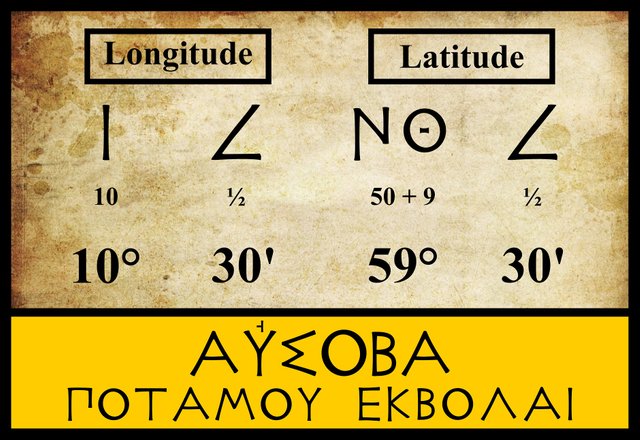
Identity
In the early 17th century, William Camden identified Ptolemy’s Ausoba with Lough Corrib and the small river which flows from it into Galway Bay:
The County of Gallway ... More inward, lies Lough Corbes (where Ptolemy places the river Ausoba) about twenty miles in length, and three or four in breadth. It is navigable, and adorn’d with three hundred Islands, which produce much grass and Pine-trees. Towards the Sea it grows narrow, and runs by Gallway, in Irish Gallive; (Camden 1380)
Later in the same century, the Irish antiquarian James Ware recorded the name of the river as Ausona, a variant that does not occur in any of the manuscript sources. I do not know how it originated:
Ausona, a River by some called Ausoba A River, which takes its rise out of Lough-Curb, and washes Galway. I take it to be the same with the River Galvia or Galiva, mentioned in the Annals of Roscommon under the Years [1177] and 1190. The River Galvia seems to have given Name to the Town of Galway. I must leave it to others to hunt after the Reason of the Name. (Ware & Harris 38)
The Dominican Annals of Roscommon do mention the drying up of the River Galvia in 1177 and 1190. Ware’s surmise that the city was named after the river is still generally accepted, though the actual etymology of the name is a matter of debate.
The Welsh Celticist, William Baxter, derived Ausoba from üisc ava, “a draught or stream of water”.
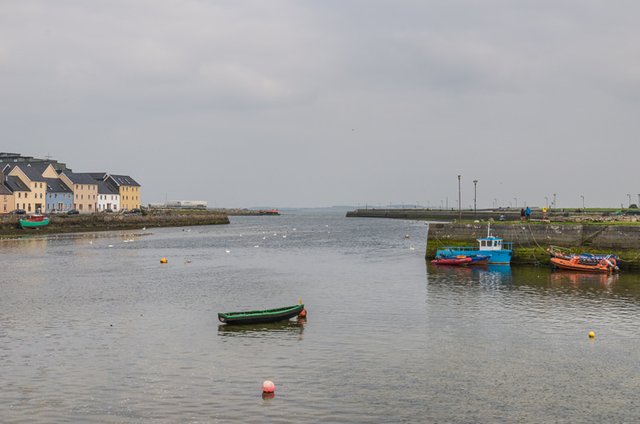
In his History of Galway, the librarian James Hardiman summarized the scholarship of the day in relation to Ptolemy’s Ausoba:
It has been generally agreed that this bay [Galway Bay] was the Ausoba of Ptolemy. Camden and Baxter are however of opinion that Lough Corrib was the place. Ware thinks it the river Galvia which takes its rise out of that lough, and washing the town, falls into the bay. Richard of Cirencester makes it Clew Bay in the County of Mayo, but Beauford, with more accuracy, thinks it the bay of Galway, which, he says, was the Abhsidhe or Abhansidhe of the Irish, and as such, it has been almost universally taken. The writer, last mentioned, states, that the word signifies Oestuarium, derived from the Irish, Auscobha, a projection of water, and although this might very properly have been classed amongst the other visionary derivatives of the same author, yet it remained uncontroverted, until Vallancey advanced another conjecture, and apparently discovered the signification of this obscure word. In his essay on the primitive inhabitants of Great Britain and Ireland, he says “commerce, with the Irish and Arabs, was esteemed honorable, and hence, in both countries, the adjective asob, noble, was prefixed to the word implying commerce, to signify a merchant.—Asob Gaelibh, the merchants of Galway, and hence Ptolemy names the bay of Galway sinus asobus.” Were this far fetched though ingenious supposition correct, it would add considerable weight to the preceding conclusions, concerning the former name and commerce of Galway; but being equally fanciful with the other, it must be abandoned, as one of the etymological reveries of the veteran antiquary, in his endeavours to give an oriental cast to the antiquities of Ireland; nor shall the reader be longer detained on the elucidation of a subject more difficult than important, at the present day, and which shall therefore be consigned to the conjectural inquiries of some abler etymologist. (Hardiman 5)
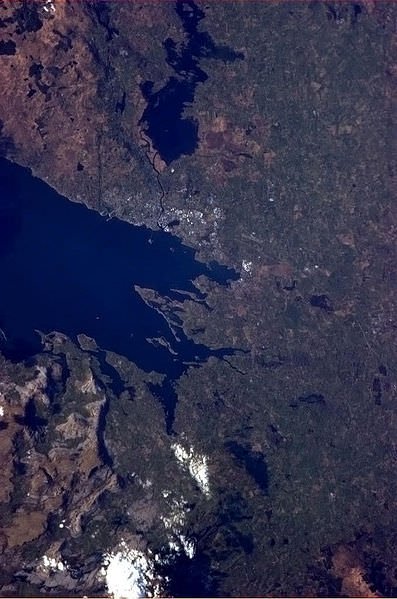
In his 1883 edition of the Geography, Karl Müller endorsed the received opinion that Ptolemy’s Ausoba was the Galway River. Charles Trice Martin emended the name to Ansoba, which he too identified with the Galway River, and around the same time, Goddard Orpen tentatively agreed.
In more recent times, the experts have revisited the etymology of the name:
Αυσοβα river mouth (Ausoba 2,2,4) was Galway Bay, into which the main inflowing river was the Corrib. This name looks like a compound of PIE *aus- ‘to shine’ (hence words for ‘east’) and *oba ‘water, river(bank)’ discussed here, presumably describing how the coastline inside the bay is so far east from the Atlantic. Ptolemy’s coordinates (as they have survived) actually place Αυσοβα due east of Σηνου, which has contributed to some debate about name locations in the west. Ausona, an unlocated city near the east coast of Italy north of Naples is a good parallel (Roman Era Names)
There is, therefore, a broad consensus that Ptolemy’s Ausoba refers to either Galway Bay, or the River Corrib that flows into it—or possibly to Lough Corrib itself. Hardiman’s assertion that Richard of Cirencester identified it with Clew Bay is curious. The Description of Britain does not mention Clew Bay by name, but does refer to “a recess of the bay of Ausoba”. This is a fair description of Clew Bay, which is indeed “recessed”. Although the Description of Britain was once attributed to the 14th-century scholar Richard of Cirencester, it is now thought to be an 18th-century forgery. Nevertheless, the possibility that Ausoba refers to Clew Bay or to one of the rivers that flow into it should not be discarded.
Over the centuries, a few other candidates for the River Ausoba have been proposed. Some of these we have already met in connection with two other Ptolemaic rivers on the west coast, the Ravios and Libnios, which I have identified with the Erne and the Moy respectively. Thomas Wright, for example, suggested Killala Bay in his 1849 History of Ireland (Wright 3), while William Gregory Wood-Martin proposed the River Moy, which flows into Killala Bay (Wood-Martin 231). In his Dictionary of Ancient Geography of 1773, Alexander MacBean noted that some scholars had identified Ptolemy’s Ausoba with “the Gyll, which runs into the sea at Sligo” (MacBean 113). This is the Garavogue River, which drains Lough Gill.
The only other candidates for the Ausoba that I have come across are late additions to the list:
It is difficult to take either of these suggestions seriously. The Doonbeg is an obscure stream, while the Feale lies south of the Shannon, which is surely to be identified with the next item on Ptolemy’s list, the Senos. Alan Mac an Bhaird, who proposed the Feale, does equate the Shannon with the Senos, so his identification of the Ausoba with the Feale requires an emendation of Ptolemy’s order, which is contradicted by all surviving manuscripts.
| Corrib or Galway Bay | Doonbeg | Feale |
|---|---|---|
| Camden (1607) | - | - |
| Ware (1654) | - | - |
| Baxter (1733) | - | - |
| O’Conor (1766) | - | - |
| Hardiman (1820) | - | - |
| Martin (1892) | - | - |
| Orpen (1894) | - | - |
| - | - | Mac an Bhaird (1991-93) |
| Francis (1994) | - | - |
| Ikins (1996-2005) | - | - |
| - | Stempel (2002) | - |
| Darcy & Flynn (2008) | - | - |
Source: Darcy & Flynn 56
My preferred candidate for the Ausoba is the River Corrib. This is not one of the principal rivers of Ireland, but there are no outstanding candidates to choose from. No major rivers discharge into the Atlantic between the Moy and the Shannon, and as the latter is surely to be identified with Ptolemy’s next river, the Senos, that leaves us with little to choose from.
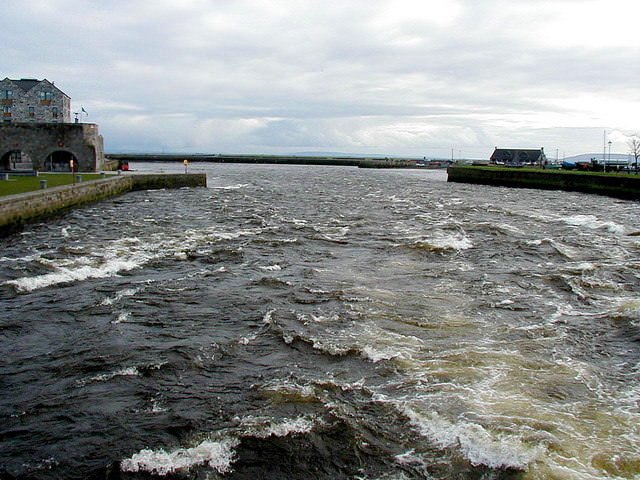
References
- William Baxter, Glossarium Antiquitatum Britannicarum, sive Syllabus Etymologicus Antiquitatum Veteris Britanniae atque Iberniae temporibus Romanorum, Second Edition, London (1733)
- William Beauford, Letter from Mr. William Beauford, A.B. to the Rev. George Graydon, LL.B. Secretary to the Committee of Antiquities, Royal Irish Academy, The Transactions of the Royal Irish Academy, Volume 3, pp 51-73, Royal Irish Academy, Dublin (1789)
- William Camden, Britannia: Or A Chorographical Description of Great Britain and Ireland, Together with the Adjacent Islands, Second Edition, Volume 2, Edmund Gibson, London (1722)
- Robert Darcy & William Flynn, Ptolemy’s Map of Ireland: A Modern Decoding, Irish Geography, Volume 41, Number 1, pp 49-69, Geographical Society of Ireland, Taylor and Francis, Routledge, Abingdon (2008)
- Louis Francis (editor, translator), Geographia: Selections, English, University of Oxford Text Archive (1995)
- James Hardiman, The History of the Town and County of the Town of Galway, W Folds & Sons, Dublin (1820)
- Alexander MacBean, A Dictionary of Ancient Geography,
- Charles Trice Martin, The Record Interpreter: A Collection of Abbreviations, Latin Words and Names Used in English Historical Manuscripts and Records, Reeves and Turner, London (1892)
- Karl Wilhelm Ludwig Müller (editor & translator), Klaudiou Ptolemaiou Geographike Hyphegesis (Claudii Ptolemæi Geographia), Volume 1, Alfredo Firmin Didot, Paris (1883)
- Karl Friedrich August Nobbe, Claudii Ptolemaei Geographia, Volume 2, Karl Tauchnitz, Leipzig (1845)
- Charles O’Conor, Dissertations on the History of Ireland, G Faulkner, Dublin (1766)
- Goddard H Orpen, Ptolemy’s Map of Ireland, The Journal of the Royal Society of Antiquaries of Ireland, Volume 4 (Fifth Series), Volume 24 (Consecutive Series), pp 115-128, Dublin (1894)
- Claudius Ptolemaeus, Geography, Biblioteca Apostolica Vaticana, Vat Gr 191, fol 127-172 (Ireland: 138v–139r)
- Patrizia de Bernardo Stempel, Ptolemy’s Celtic Italy and Ireland: A Linguistic Analysis, in David N Parsons & Patrick P Sims-Williams (editors) Ptolemy: Towards a Linguistic Atlas of the Earliest Celtic Placenames of Europe, University of Wales, CMCS Publications, Aberystwyth (2000)
- Charles Vallancey, An Essay on the Primitive Inhabitants of Great Britain and Ireland, Graisberry & Campbell, Dublin (1807)
- James Ware, Walter Harris (editor), The Whole Works of Sir James Ware, Volume 2, Walter Harris, Dublin (1745)
- Friedrich Wilhelm Wilberg, Claudii Ptolemaei Geographiae, Libri Octo: Graece et Latine ad Codicum Manu Scriptorum Fidem Edidit Frid. Guil. Wilberg, Essendiae Sumptibus et Typis G.D. Baedeker, Essen (1838)
- W G Wood-Martin, Traces of the Elder Faiths of Ireland : A Folklore Sketch : A Handbook of Irish Pre-Christian Traditions, Longmans, Green & Co, London (1901)
- Thomas Wright, The History of Ireland: From the Earliest Period of the Irish Annals to the Present Time, Volume 1, John Tallis and Company, London (1849)
Image Credits
- Ptolemy’s Map of Ireland: Wikimedia Commons, Nicholaus Germanus (cartographer), Public Domain
- Greek Letters: Wikimedia Commons, Future Perfect at Sunrise (artist), Public Domain
- River Corrib, Galway: © Ian Capper, creative Commons License
- Galway Bay (From the International Space Station): Wikimedia Commons, Chris Hadfield (photographer), Public Domain
- Mouth of the River Corrib: © John Lucas, Creative Commons License

I love history writing of yours
wow.what such a amazing history really amazing i like your post thanks for share dear @harlotscurse
Excellent history good post i like your post thanks for share dear @harlotscurse
Wow! Such a wonderful history and very nice article. Thanks for share this post.
Excellent post good article very nice history I like your post thanks for share dear @harlotscurse
Ireland is such a great country. I like its natural beauty and people attitude.
really very talented history of ireland.. This type of content is very valuable here at Steemit and it is very valuable, you have been uploading very good quality content to Steemit for a long time and I love learning more because I can discuss new topics with my friends, I just have to give them the Thank you. my dear good friend.. @harlotscurse
@sadkitten is countering 50% of @timuann self-votes for 1 week starting Friday, August 31st 2018 because it is part of last weeks top self-voters. For more details see this post.
Ireland is one of most beautiful place in the world
Very good post on Irish history..
Love you buddy
Congratulations @harlotscurse! You have completed the following achievement on Steemit and have been rewarded with new badge(s) :
Click on the badge to view your Board of Honor.
If you no longer want to receive notifications, reply to this comment with the word
STOP